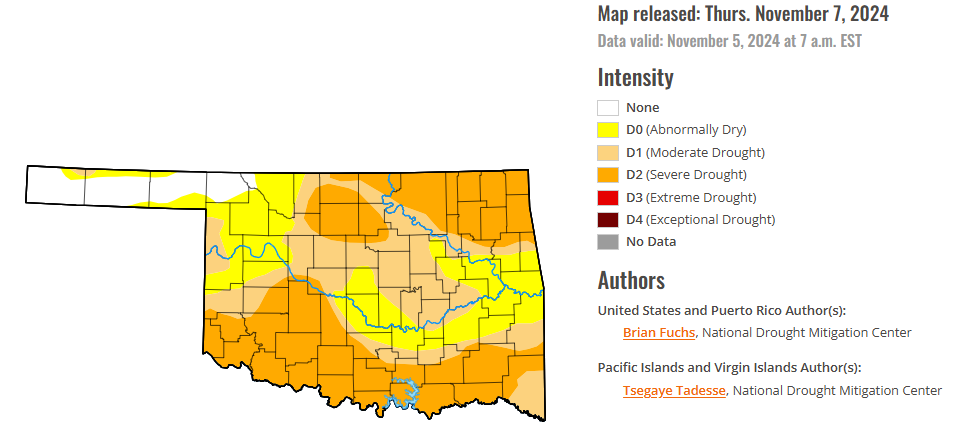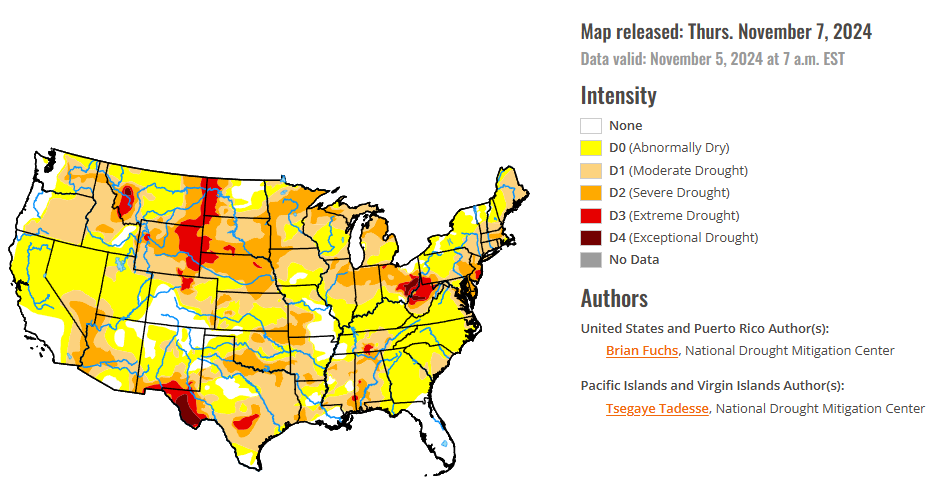
To view the latest Oklahoma drought map, CLICK HERE.
According to the latest Oklahoma drought monitor report, exceptional drought remains at zero percent, unchanged from the start of the calendar year.
Extreme drought or worse conditions have been eliminated, down from 41.57 percent last week.
Severe drought or worse conditions have decreased to 41.55 percent, down from 67.70 percent last week.
Moderate drought or worse conditions have decreased to 67.84 percent, down from 83.54 percent last week.
Abnormally dry or worse conditions decreased to 92.26 percent, down from 92.27 percent last week.
According to the 6-to-10-day precipitation outlook map, nearly the entire state of Oklahoma is leaning above a 33-40 percent chance of precipitation through November 16, 2024. Only the Northeast quarter of the state is leaning above a 40-50 percent chance of precipitation through that November 16 date.

To view the United States Drought Map, CLICK HERE.
According to the latest U.S. Drought Monitor, over the last week, weather systems tracked over the southern Plains and into the Midwest, bringing much-needed precipitation. Some areas of Arkansas and Missouri reported over 10 inches of rain for the week. The active pattern also continued over the Pacific Northwest, with the coastal areas and inland recording 2-4 inches of rain that helped to alleviate dryness. Temperatures over the West were below-normal for the week, by as much as 6-9 degrees in parts of Nevada, Utah and Arizona. The rest of the country had warmer-than-normal temperatures, especially in Texas and into Louisiana, Mississippi, Arkansas and Alabama, where they were 9-12 degrees above normal. Many areas that received rain during the period had these rains come on the cusp of record-setting dryness in October, but many records were still set for areas that didn’t receive rain at the end of October and early November.
In the Southern Plains, temperatures were 12-15 degrees above normal, with areas of the Texas Panhandle into Oklahoma 6-9 degrees above normal. Much of Oklahoma and north Texas and Arkansas received significant precipitation, with widespread reports of 800% of normal rain for the week. The dryness continued over much of Tennessee and into northern Mississippi as the active rain patterns brought some rains, but not the significant and widespread rains that were more common in the West. A full category improvement was made over much of Oklahoma and northern Texas and western Arkansas, with extreme drought removed from the region. Extreme drought emerged in southeast Mississippi. Severe drought improved in Louisiana with moderate drought and abnormally dry conditions also improving in southern Louisiana.
In The High Plains, significant rains fell over much of Kansas, into southeast Nebraska and southeast Colorado. Rain and snow fell from portions of eastern Colorado into Wyoming and into the Dakotas too, reversing the trend of very dry conditions. Not all areas were as fortunate, with northeast Colorado, western Nebraska, eastern and southwest South Dakota and northwest North Dakota remaining dry this week. The region was split, with temperatures in the western areas 3-6 degrees below normal, and temperatures 9-12 degrees above normal in much of eastern Nebraska and eastern Kansas. Much of eastern Kansas saw a full category of improvement this week, with extreme drought being removed from the southeast. Severe drought was removed from far southeast Nebraska. In western North Dakota and in eastern Montana, severe and extreme drought expanded slightly. Some improvements were made to abnormally dry conditions over central to southern Colorado and to moderate drought over northeast Colorado. Moderate drought expanded across central South Dakota this week.
In the West, precipitation was scattered, with the greatest rain over the Pacific Northwest, where 200% of normal rain was recorded for the week in much of Oregon and Washington. Cooler-than-normal temperatures dominated the region with many areas of Nevada, Utah, and Arizona and into western Wyoming 6-9 degrees below normal for the week. Dryness continued to dominate much of Montana with abnormally dry conditions expanding to fill the rest of the state and moderate and severe drought expanding in the west. Abnormally dry conditions spread to the rest of central Utah while moderate drought and abnormally dry conditions improved over much of western Oregon and Washington. Some improvements were made over eastern New Mexico this week as a result of the continued wetter conditions
Looking ahead, over the next 5-7 days, it is anticipated that the wet pattern will continue over much of the southern Plains and into the South, Southeast, and Midwest. The active pattern along the coastal areas of the Pacific Northwest will also continue. Greatest precipitation is anticipated over the southern Plains, western Tennessee, western Kentucky, northern Mississippi, southern Georgia, western South Carolina and the Pacific Northwest coast, where 3 or more inches of rain is anticipated. Much of the West will remain dry. Temperatures will remain cooler than normal over much of the West with departures of 10-12 degrees below normal over northern New Mexico and southern Colorado. Much of the eastern half of the country will be warmer than normal, while areas of the Midwest and South are anticipated to be 10-12 degrees below normal for the week. Hurricane Rafael has formed in the Gulf of Mexico and is projected to track westward. It may not make landfall until the middle of next week but could impact the dryness over the South and southern Plains depending on its path.
The 6-10 day outlooks show that the probability of above-normal temperatures will be greatest over the eastern half of the United States, especially over the Midwest and into the Southeast. Chances of cooler-than-normal temperatures are greatest over the West, in particular over California and Nevada. Most of the country has a good chance of recording above-normal precipitation during the period, especially over the Pacific Northwest..
To view the 6-10 Day Precipitation Outlook Map, click here.
To view the 6-10 Day Temperature Outlook Map, click here.
To view the Monthly Drought Outlook Map, click here

















